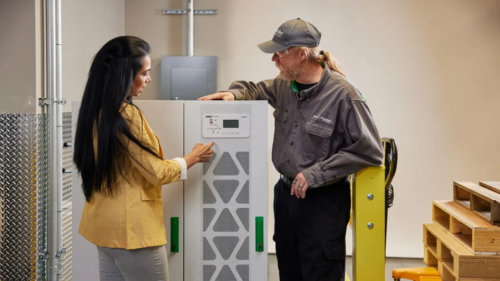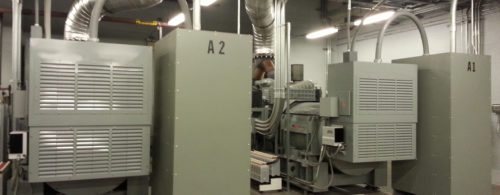How to specify an indoor lighting system
By following a few guidelines, engineers and lighting designers can specify the correct lighting system for a facility.
Learning Objectives
1. Understand which lighting type is correct for each application
2. Know which energy codes pertain to the project
3. Know how to write the specification to get the achieved light.
The design is complete; now it’s time for the luminaire schedule. Where should you start? You know that the architect wanted to use a fancy pendant luminaire in the offices and your office usually uses Brand X for the recessed 2×4. But the interior designer wanted that decorative thing for the lobby and the washrooms need that odd-looking sconce. How are you going to make sure the correct product gets bid and installed on the project? Here are some guidelines that make the task easier.
Luminaire description
Most experienced lighting designers and engineers find that the luminaire description is the key to getting the proper product. A good description leaves little doubt of the intended luminaire, while a weak description leaves the door wide open for interpretation.
For example, if you want to use a recessed LED down light, which of these descriptions would produce the desired results?
1. Architectural recessed round aperture dimmable LED down light, nominal 6-in. diameter aperture by 6.75-in.-high steel housing with extruded aluminum heat-sink matte clear reflector with convex transitional lens
2. Recessed round aperture LED down light nominal 6-in. diameter aperture with lens.
Option No. 1 will take extra time, but a little additional time at the beginning of the process will save a significant amount of time when the submittals arrive at your desk. Option No. 2 means that you will be inundated with substitution requests, or when the submittal shows up, you will find that each manufacturer has several luminaires that meet your description and none of them is the one you wanted.
You can, however, go too far with your description and quickly push out competition and end up breaking the budget. Using a description such as this is going to fit only one luminaire manufacturer and one model from that manufacturer: Surface mount high-intensity discharge (HID) projector 11.6-in. overall length by 4.3-in. aperture aluminum housing with 10.1-in. long aluminum yoke to provide 359 deg of rotation.
Now you’ve created a one-manufacturer specification, which could be problematic if it’s a competitive bid project. A description this precise should only be used when there is only one option that meets the project requirements.
Naturally this rule can be broken when it comes to “white goods”; those strip lights and 2×4-ft 18-cell troffers that don’t require an extensive description because there aren’t many differences between the manufacturers. In this case a description like this provides enough information so you can be fairly certain that you will get several options that are equal in performance and price: recessed 2×4-ft lensed troffer with #12 pattern acrylic lens.
If you’re lighting a parking lot with 250 W Metal Halide Shoebox on 30-ft poles, several manufacturers can meet the requirements, so a generic description should suffice. Just remember to note any limitations that may exist on your project, such as house side shield in the shoe box or wire cages for your strip lights.
One final note: It’s easy to copy and paste from an old schedule, but if you don’t review your descriptions, you might just find the 2×4-ft lensed troffer that the project needed showed up as a 2×4-ft louvered troffer.
Lamps/LED
Aren’t all lamps the same? No, not all lamps are created equal; they’re not even equal among the same manufacturer. Several manufacturers have two or three different quality levels among each of the lamp styles. Did you know that the linear fluorescent 700 series phosphor lamps not only have lower CRI but also produce fewer lumens than the same wattage 800 series lamps? Does your project require good color rendering? If it does, then the 700 series lamps are not an option for you, only the 800 series are. Is the project planning on getting any energy credits or rebates? Is it planning on using the low-wattage linear lamps? Does your design take into account the lower lumen output for the lamps? There are a lot of fluorescent lamp questions that need to be asked and answered prior specification.
Once you answer these and other questions, the selection process can begin. As with most things it is best to stick with what is familiar; Osram, GE, and Philips are the main competitors in the lamp market and should be considered first. If these manufactures can’t meet the needs of your project, several others are waiting in the wings; Fulham and Ushio are examples.
When specifying fluorescent lamps it is important to provide lamp shape, wattage, and color temperature. Telling a contractor to provide a 32 W lamp is only giving part of the necessary information and can lead to some very strange submittals. There are 32 W fluorescent lamps available in linear, compact, and u-bend forms. Which form meets your requirements? Color temperature and CRI should always be listed as part of the lamp specification or as part of the general notes in your luminaire schedule. This will help ensure that the color temperature for all the lamps on the project will match. There is nothing more embarrassing than walking through your project and seeing several different colored lamps just to find that you didn’t specify a color temperature.
Choosing an HID lamp involves some of the same considerations as choosing fluorescent lamps: shape, wattage, and color temperature. In addition to these, think about lamp base, lamp orientation, and color rendering. Over the past decade, manufactures have greatly improved the color stability and color rendering of many of the popular metal halide lamps. For most of these lamps, the user can expect a color shift of only 100 to 200 degrees Kelvin over the life of the lamp—a vast improvement over the 500 to 800 degrees Kelvin that we saw during the 1980s and 1990s.
Due to this color stability, HID lamps aren’t just for the parking lot or warehouse anymore; they have moved inside with ceramic metal halide (CMH) options. These lamps have very stable color and perform similar to the incandescent or halogen sources. A 20 W CMH will easily replace a 50 W halogen in light output with significant energy savings, rated life, and quality of light. Many other low-wattage lamps are making their way into retail projects and office lobbies. However, that 20 W CMH lamp can be in several forms, MR16, PAR, and T4.5, which add more complexity to the selection. When using the MR or PAR style lamp, think about beam angle; the T4.5 will require additional information in the luminaire description to address the reflector distribution. Similarly, if you are illuminating a parking lot, the shape of the 400 W HID lamp will dictate the available reflector options and affect the overall size of the luminaire.
HID lamps have several forms and base options that require attention during specification. HID lamps are available in roughly 20 different shapes and 12 base configurations that vary depending on wattage. Be certain to review the socket information for your luminaire; more than once I have called for a medium base when the luminaire required a mogul base. Unfortunately, there is no magic formula for mogul base v medium base for wattages less than 250; above 250 W and you can be fairly certain that it will have a mogul base.
A few final notes on HID lamps: Not all HID lamps can be used in horizontal and vertical orientations, and the rated life for universal burn lamps varies depending on the orientation. Make sure that your HID lamp is safe for your luminaire application. Due to the potential for “nonpassive failure” some HID lamps are safe only in enclosed luminaires.
The process of choosing LEDs warrants an entire article unto itself (see April 2012, page 28). Here are a couple of guidelines: Check the lumens in the Illuminating Engineering Society (IES) file and make sure to pay attention to the color temperature and the rated life. The rated life for an LED is not rated to failure like a standard lamp but to 70% of initial output (L70) and should always be noted as “based on IESNA LM-80-2008.”
Ballast/driver
Ballasts are by far one of the most challenging sections of the schedule. Why? Because there are so many variables: electronic, magnetic, program start, rapid start, pulse start, low ballast factor, dimming, and more. There are many different manufacturers for each type of ballast. Visit the websites of various manufacturers to obtain information: GE, Sylvania, Philips, Fulham, Vossloh-Schwabe, Robertson, and Hatch.
So where do you start? If you live in an area that has a local energy code, such as California’s Title 24 or the Oregon Energy Efficiency Specialty Code, some of the options may have been narrowed down for you. In Oregon, for example, magnetic fluorescent ballasts have been legislated out for interior lighting projects. The state also legislated out the use of probe start metal halide for certain wattage lamps.. Make certain that you review the most current code to ensure the ballast selected meets local requirements.
When selecting fluorescent ballasts, the first choice typically should be NEMA Premium. By using this program as a standard, engineers can automatically narrow the search to companies with strong backgrounds in the industry and that have the collective goal of making energy-efficient products. If you are specifying compact fluorescent or T5 lamps, you can’t always find the ballast necessary for your project on the NEMA list. For these lamps, it is still advisable to use the same manufacturers that are part of the NEMA program. The items that should be reviewed before making a ballast selection are ballast factor, system lumens, and input power.
Ballast factor is a factor of relative light output as compared to reference ballast. Linear fluorescent ballasts are generally available in low (0.7 to 0.8), normal (0.85 to 1.0), and high (1.0+). For example, a “normal” ballast factor of 0.85 provides 85% of the lamp’s rated lumens; in the case of a 3100 lumen T8 lamp the lumens would be 2635. Compact fluorescent and T5/T5HO lamp ballasts have ballast factors that range from 0.88 to 1.07. Why is this important? If you have a single lamp T8 luminaire that is 50% efficient and have a normal ballast factor with a 3100 lumen T8 lamp, your luminaire is only delivering 1318 lumens. Many ballast manufactures provide some of that math for you in the form of the system lumens column in the ballast catalog. The final item is input power or how many Watts the lamp/ballast combination uses. This very important column provides accurate information for filling out energy code documentation and circuiting the lighting.
When specifying dimming lights, think about the controls for the luminaire. Are they going to be 0 to 10 V? Is there a digital control system planned for the project? How the luminaires are controlled will influence your dimming options. How low do you need to dim the luminaire? It is common for T5/T5HO ballasts to dim to 1% light output, but there are only a couple of T8 dimming ballasts that can go below 5% light output, so it is important to know what is required for your project. For LED luminaires there are different levels for dimming, from those that don’t dim to those that dim to 10%. Currently there are very few LED luminaires that dim below 10%, but that should be changing in the next couple of years. The dimming needs of your project should be considered when selecting an LED luminaire.
A few more items to be aware of when selecting a fluorescent ballast: Some lamp/ballast manufacturers will offer extended warranties when the lamp and ballast are from the same manufacturer. If your luminaire is controlled by occupancy sensor and is in a location that will have several on/off cycles per day, specifying a program start ballast will help prolong the life of your lamp.
A word of caution on fluorescent ballasts: Just because you specify a particular ballast doesn’t mean it is going to fit in your luminaire. Not all ballast manufacturers list the housing size for their ballasts, and when they do list the size it doesn’t mean the ballast will fit into the luminaire. In these cases the manufacturer’s representative should be able to provide ballast options that meet the project requirements and luminaire constraints.
Ballasts for HID luminaires can be challenging, though not as challenging as fluorescent. There are limited options: electronic, magnetic, and magnetic pulse start. Electronic ballasts are primarily for lower wattage lamps at 20 to 150 W. These ballasts are designed to optimize the energy performance of the system. The smaller size of this ballast allows the luminaire manufacturer to build smaller HID luminaires. Magnetic pulse start ballasts cover a wide range of lamp wattages, up to 1000 W. The Energy Independence and Security Act of 2007 (EISA), which took effect in January 2009, helped push pulse start metal halide ballasts to the forefront by legislating out the probe start metal halide lamp and ballast for wattages of 150 to 500 W. In addition, EISA pushed the manufacturer of pulse start ballasts to make the ballast more efficient for those same wattages. Today we all benefit from the legislation, not just in energy savings but also in time saved, while writing luminaire specification of metal halide systems.
Magnetic probe start metal halide lamp ballasts are still available in wattages higher than 1000 W and for use with 150 W lamps rated for use in wet locations. Similar to the caution noted for fluorescent ballasts, it is not uncommon to specify an HID ballast that does not fit or cannot be used in your specified luminaire.
Manufacturer information
This is the final step in a good specification, and at our firm it is the most contentious. It is important to give the electrical contractor or distributor a basis of design for the luminaire that fulfills the needs of your project. The contentious part is how much information to provide.
Let’s go back to the example description—architectural recessed round aperture dimmable LED downlight nominal 6-in. diameter aperture by 6.75-in.-high steel housing with extruded aluminum heat-sink matte clear reflector with convex transitional lens. This description is based around Portfolio’s LD6x series LED recessed downlight.
To this point, we have discussed the luminaire description, lamping, and ballasts, which are the major components of the luminaire. There are several options on every luminaire that we have not discussed (reflectors, lenses, finishes) because the options are project specific. This doesn’t mean that they are not important, but we should assume that each luminaire schedule has sections or columns that allow engineers to specify these options.
These options are being described as part of the luminaire description “matte clear reflector,” and if your schedule is similar to the one our firm uses, you have a section to list the reflector, which means that this information is listed twice. Do we need to list it yet again by providing the actual catalog number in this “manufacturers” section? If we list it again as part of a complete catalog number (LD615D010 ERM6835 6ML1WMH), who is responsible if we get the reflector information wrong? In this case, “WMH” defines warm haze for the reflector finish, but what if I had typed “WHH” and had not noticed this error? The contractor would order wheat haze. This could be a very expensive mistake, even though I stated matte clear in the description and again in the reflector section of the schedule. The electrical contractor has a strong case to get me to share in the cost of fixing the mistake.
The discussion in our firm is always how much information to provide in this last basis of design section. If we only list the series information “Portfolio LD6x Series,” does that provide the contractor with enough information for our intent? Many believe that if you let a contractor interpret what you want, you are destined to fail. For me, the fact that a manufacturer’s product specification
has a disclaimer that states “specifications and dimensions subject to change without notice” at the bottom of every page means that I should not provide a catalog number. This disclaimer tells me that there is a chance something in that catalog number will change between when I specify the project and when the product is ordered. This means that the electrical contractor has to interpret
the designer’s intensions. However, with a good description, lamp, and ballast
information along with the manufacturer and series number, there is very little to interpret. The designers also should review shop drawings to ensure model
numbers match the description.
Strong specifications start with the proper description of the desired product and are supported with the proper lamp and ballast information together with the desired manufacturer and series information. When you follow these guidelines, the proper product will be delivered to the project.
Michael Larsen is an associate and senior lighting designer at Interface Engineering. His interior and exterior lighting design portfolio is extensive and includes hospitality, high-end custom homes, offices, retail, schools, and healthcare facilities. Larsen has provided lighting and daylighting design on dozens of LEED-certified projects, several of which received LEED Platinum.
Do you have experience and expertise with the topics mentioned in this content? You should consider contributing to our CFE Media editorial team and getting the recognition you and your company deserve. Click here to start this process.




